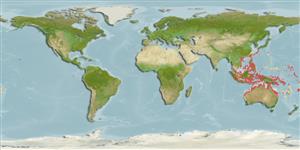Environment: milieu / climate zone / depth range / distribution range
Ecology
Marine; brackish; reef-associated; depth range 2 - 20 m (Ref. 48637). Tropical; 30°N - 31°S, 99°E - 175°W
Western Pacific: Borneo, Philippines, and northwest Australia to Samoa, north to the Ryukyu Islands, south to New South Wales, Australia and Tonga.
Size / Weight / Age
Maturity: Lm ? range ? - ? cm
Max length : 31.0 cm TL male/unsexed; (Ref. 9710)
Inhabits muddy substrates, usually shallow coastal slopes to about 20 meters depth and in shallow estuaries (Ref. 48637). Occurs in estuaries, sheltered reef flats, and lagoons to a depth of more than 17 m. Common in seagrass beds and sandy areas; juveniles found among mangroves (Ref. 1602). Benthopelagic (Ref. 58302).
Life cycle and mating behavior
Maturities | Reproduction | Spawnings | Egg(s) | Fecundities | Larvae
Myers, R.F., 1991. Micronesian reef fishes. Second Ed. Coral Graphics, Barrigada, Guam. 298 p. (Ref. 1602)
IUCN Red List Status (Ref. 130435)
Threat to humans
Harmless
Human uses
Tools
Special reports
Download XML
Internet sources
Estimates based on models
Preferred temperature (Ref.
123201): 25 - 29.3, mean 28.5 °C (based on 2174 cells).
Phylogenetic diversity index (Ref.
82804): PD
50 = 0.5000 [Uniqueness, from 0.5 = low to 2.0 = high].
Bayesian length-weight: a=0.02630 (0.01523 - 0.04541), b=2.85 (2.71 - 2.99), in cm total length, based on LWR estimates for this species & Genus-body shape (Ref.
93245).
Trophic level (Ref.
69278): 3.8 ±0.0 se; based on diet studies.
Resilience (Ref.
120179): High, minimum population doubling time less than 15 months (Preliminary K or Fecundity.).
Fishing Vulnerability (Ref.
59153): Low vulnerability (21 of 100).
Nutrients (Ref.
124155): Calcium = 46.9 [19.5, 137.8] mg/100g; Iron = 0.618 [0.306, 1.394] mg/100g; Protein = 18.8 [16.7, 21.0] %; Omega3 = 0.122 [0.064, 0.231] g/100g; Selenium = 27.4 [13.0, 60.3] μg/100g; VitaminA = 50.6 [13.4, 195.8] μg/100g; Zinc = 1.17 [0.76, 1.76] mg/100g (wet weight);
